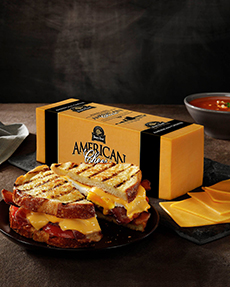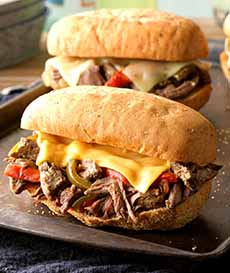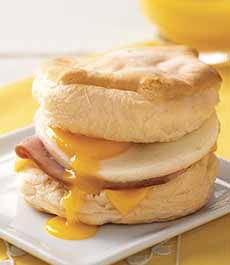PRODUCT: American Cheese (What Is It?)
|
September 18th was National Cheeseburger Day. It inspired us to create this history of the cheese that tops more cheeseburgers than any other: American cheese. But is American cheese “real” cheese? Not in the sense that blue, cheddar, Swiss and other cheeses are. It is made from milk, but not with the traditional cheese-making process of separating curds from whey and then packing the curds into a block. Instead, it is made by by processing cheese trimmings with emulsifiers, salt, and coloring, classified by the USDA as “processed cheese.” British colonists arrived in America with a preference for cheddar cheese. In the New World, before the advent of commercial producers, a basic cheese was made at home. The first cheese factory in the U.S., founded in 1851 in New York, made cheese that anyone could buy—thus saving the housewife the labor of making cheese. The proprietor, Jesse Williams, purchased milk from local herds and pooled it to make cheese. Other cheese-makers followed suit. Soon, generic, factory*-made cheddar became common throughout the country. Terminology evolved such that many Americans simply called this type of cheddar “store cheese” or “yellow cheese.” These early colonial cheddars weren’t as tasty as fine English cheddars, but they were so cheap that they could be shipped to England and sold for a profit. By 1878, Americans were exporting more than 300 million pounds of cheese to England each year. British consumers didn’t think much of the quality of the “Yankee cheddar” or “American cheese,” but it sold well due to its low price [source]. In 1916 James L. Kraft, a cheddar cheese wholesaler in Chicago, patented a process to reduce waste of leftover pieces of cheese. He shredded the cheddar, re-pasteurized it through heating, and added some sodium phosphate as an emulsifier. The resulting product was cheaper than cheddar, with a longer shelf life—and, may we add, far less flavorful, and made from inferior cheese. But money talks, and it sold well. By 1930 Kraft cheese represented 40% of cheese consumed in the U.S. [source]. The name “American cheese” gradually came to refer to Kraft’s processed cheese [source]. Hand-sliced at the store, the cheese slices would vary in thickness, dryness, etc. It took 15 years to figure out how to slice the rectangular bricks of cheese into individual slices (not as easy as it sounds—read the story here). But in 1950, Kraft De Luxe Process Slices, eight square slices sized for a piece of bread, debuted. They became a go-to for burgers, grilled cheese sandwiches, cheese omelets and more. However, it was not an ideal solution. The it was typically difficult to peel the slices apart without tearing them. In 1956, an outside inventor patented machinery to create individually-wrapped slices of cheese. Kraft created a similar technology, and Kraft Singles were introduced in 1965 (source). Velveeta is a processed cheese product that tastes like American cheese, but softer and spreadable. Invented in 1916, it was sold to Kraft in 1927. Customers love its meltability. |
|
|
|
Velveeta has even less cheese than American cheese, and is labeled by the USDA as a “Pasteurized Prepared Cheese Product” [source]. Cheez Whiz, classified as a cheese sauce or spread, is made of whey (a protein byproduct of milk), oil, sodium-heavy flavorings, and colorants and emulsifiers that make it bright yellow and shelf-stable. October is American Cheese Month, but it doesn’t celebrate the American cheese in this article. Instead, it celebrates the fine artisan cheeses made by American cheesemakers. Here’s more about it. *Here, “factory” does not refer to today’s massed-produced cheeses, but to cheese still handmade, but in larger batches.
|
||







